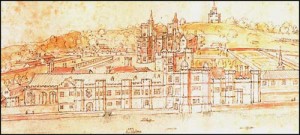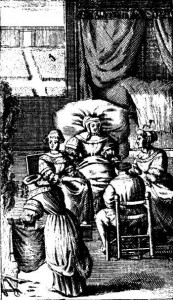On Thursday August 21, 1533, Queen Anne Boleyn and Henry VIII left Windsor for Whitehall, spending the weekend there, before moving on to Greenwich ‘where the Queen intends to take to her chamber’ (Letters & Papers, volume vi, 948, 1004).
According to Eric Ives,
‘This curious custom, part religious, part medical, part feminine mystery, would keep her secluded through the last weeks of pregnancy until she was ‘churched’, or purified, a month or more after the delivery.” (Pg. 184)
On August 26, 1533, Anne Boleyn took formal leave of the court and of the male world, and entered her confinement at Greenwich. Anne was following in the footsteps of Henry VIII’s mother, Elizabeth of York, who 42 years earlier, had given birth to Henry at the lovely, Thames-side palace.
Like Elizabeth, Anne too would follow the protocol for royal births as set out in The Royal Book, a handbook of court etiquette, already old in Tudor times, with some ‘finishing touches’ added during the reign of Henry VII (Starkey, Pg. 1).
Such an important event required elaborate ceremony and preparations had commenced earlier that month. According to David Starkey,
‘Carpenters and joiners had first prepared the skeleton by framing up a false ceiling in the chamber. Then the officers of the wardrobe had moved in to nail up and arrange the tapestry, carpets and hangings. At the last minute, gold and silver plate had been brought from the Jewel House. There were cups and bowls to stand on the cupboard and crucifixes, candlesticks and images for the altar. The result was a cross between a chapel and a luxuriously padded cell.’ (Pg. 2)
Historian Amy Licence, author of In Bed With the Tudors, questions whether or not, at such a turning point in England’s religious history, the full compliment of images, crucifixes and icons would have been on hand. She does though go on to acknowledge
‘Anne’s sympathies lay firmly with the Reformed faith, yet the use of such icons in churches would not be fully banned until the reign of Edward VI. Catholic talisman may or may not have been present at her delivery and she may or may not have used them.’ (Pg. 146)
Interestingly, Licence also claims that Anne Boleyn was ‘known to use other superstitious charms and aides such as cramp rings’ (Pg. 146).
Once the queen was ready to take to her chamber, she travelled in procession to the Chapel Royal to hear mass. The company then proceeded to the great chamber, where under the cloth of estate, the queen took wine and spices. Another procession accompanied the queen to her bedchamber door and there the men took leave of the queen.
Only women could accompany the queen in the birthing chamber, so who attended Anne?
Amy Licence believes that,
‘possibly her mother and sister-in-law Jane were present as well as her ladies in waiting, although her sister Mary may still have been absent from court.’ (Pg. 149)
What of the Queen’s bedchamber? David Starkey describes it in some detail:
‘The walls and ceiling were close hung and tented with arras – that is, precious tapestry woven with gold or silver threads – and the floor thickly laid with rich carpets. The arras was left loose at a single window, so that the Queen could order a little light and air to be admitted, though this was generally felt inadvisable. Precautions were taken, too, about the design of the hangings. Figurative tapestry, with human or animal images, was ruled out. The fear was that it could trigger fantasies in the Queen’s mind which might lead to the child being deformed. Instead, simple, repetitive patterns were preferred. The Queen’s richly hung and canopied bed was to match or be en suite with the hangings, as was the pallet or day-bed which stood at its foot. And it was on the pallet, almost certainly, that the birth took place. (Pg. 2)
In the words of David Cressy, the birthing chamber ‘became a womb, warm, dark and comfortable, restricting entry to evil spirits’ (Pg. 54).
Henry VIII’s astrologers and physicians had predicted a son and heir to the Tudor throne, and so all that was left, was for Anne to deliver.
Twelve days after having taken to her chamber, Anne Boleyn gave birth to a healthy daughter – Elizabeth.
(If you would like to read the full entry from A Collection of Ordinances and Regulations for the Government of the Royal Household pertaining to the Queen’s lying-in, click here and scroll to page 125.)
Related Articles:
The Birth of the Princess Elizabeth
Princess Elizabeth’s Christening
References A Collection of Ordinances and Regulations for the Government of the Royal Household. Henry VIII: August 1533, 11-20′, Letters and Papers, Foreign and Domestic, Henry VIII, Volume 6: 1533 (1882), pp. 418-432. URL: http://www.british-history.ac.uk/report.aspx?compid=77565 Date accessed: 25 August 2012. Cressy, D. Birth, Marriage & Death. Ritual Religion, and the Life-Cycle in Tudor and Stuart England, 2010. Ives, E. The Life and Death of Anne Boleyn, 2004. Licence, A. In Bed With the Tudors, 2012. Starkey, D. Elizabeth: The Struggle for the Throne, 2001.


















Love to read about Anne Boleyn’s confinement. I think it was of the most important moments of Anne’s life and an interesting Tudor period practice
I always feel so sad for Anne at this time as we know the out come, and how this was the begining of the end for her in some respect.
She entered that chamber with such high hopes, I imagine she must have thought of her long and incredible journey to get where she was many times while she was waiting for her child to be born, a son would have been the perfect ending to it.
A time of great anticipation, and some fear also, I would think, as childbirth was so risky then. How history would have changed if she had given Henry a son/s that lived…Poor Anne.